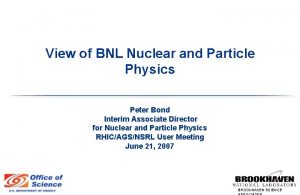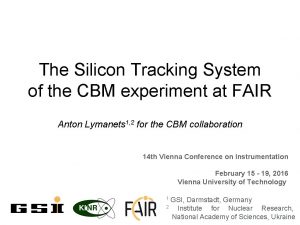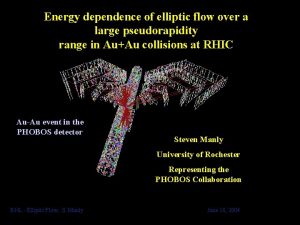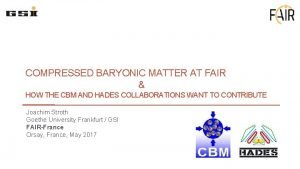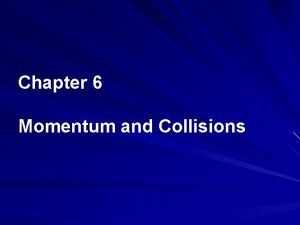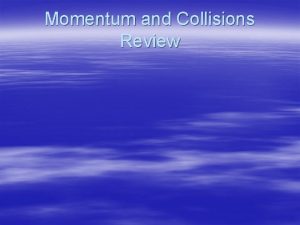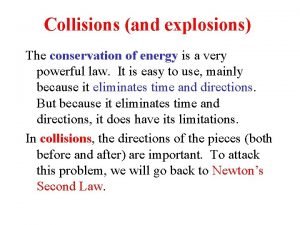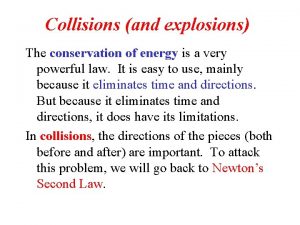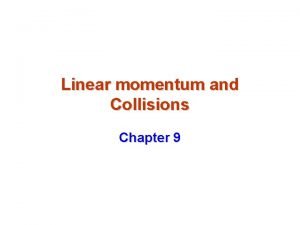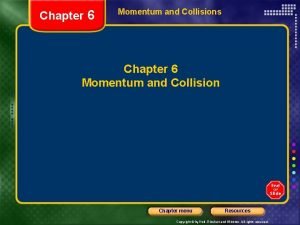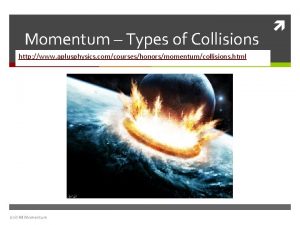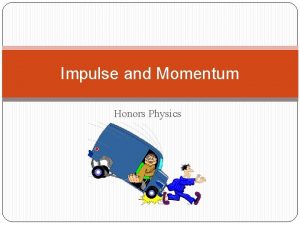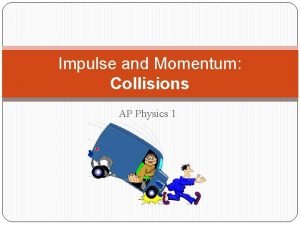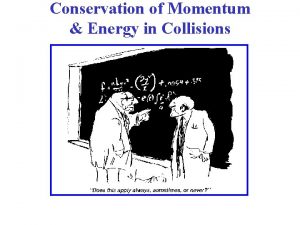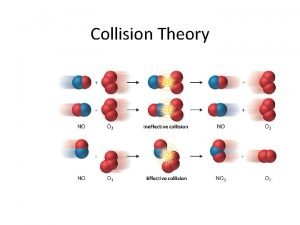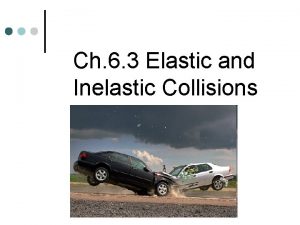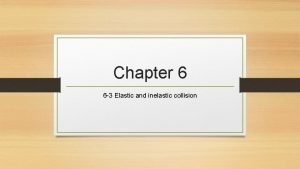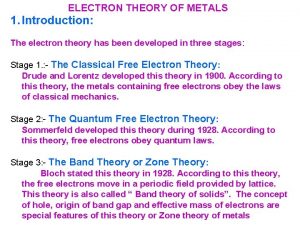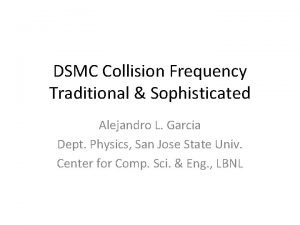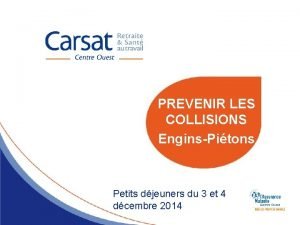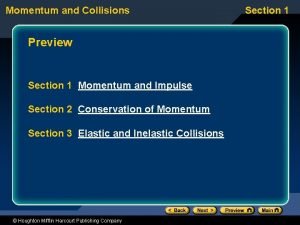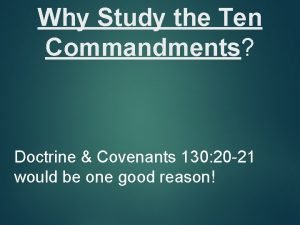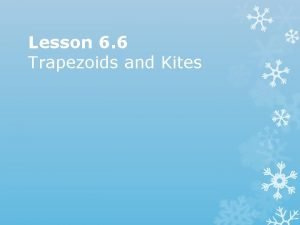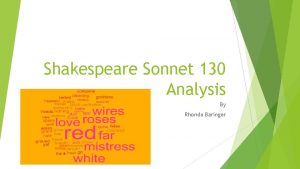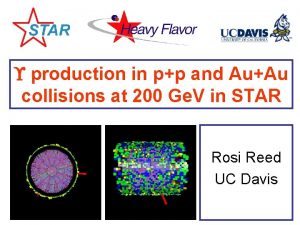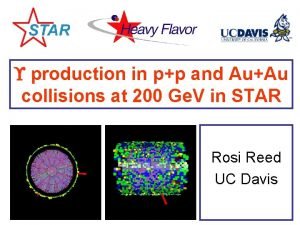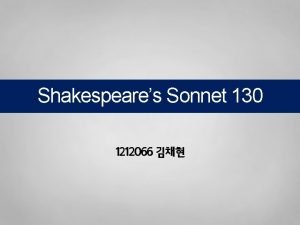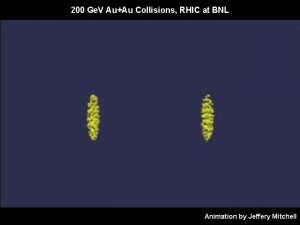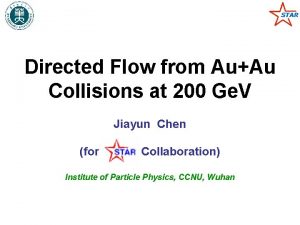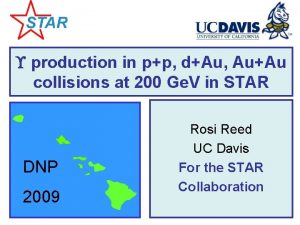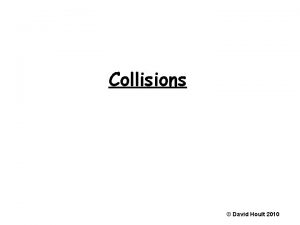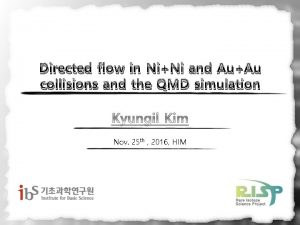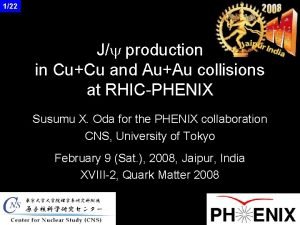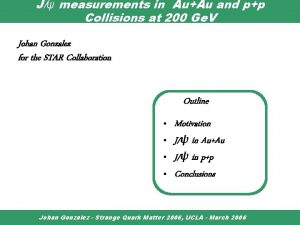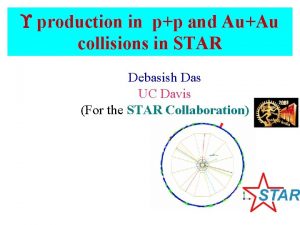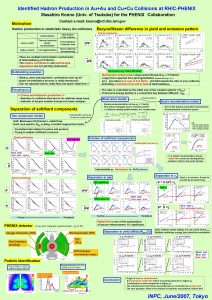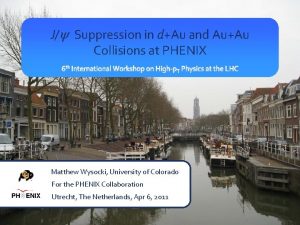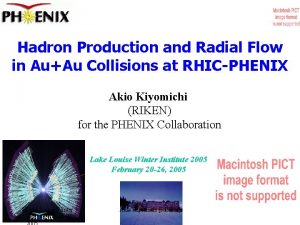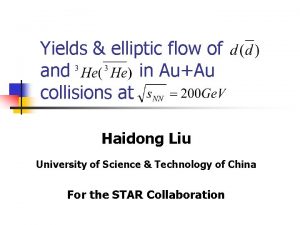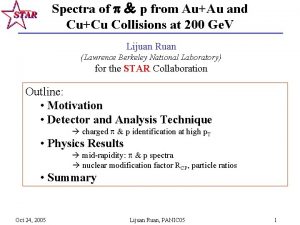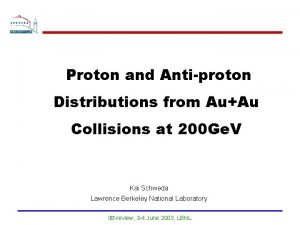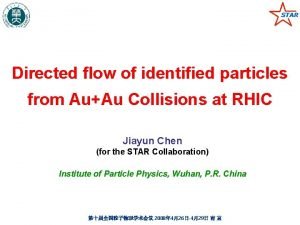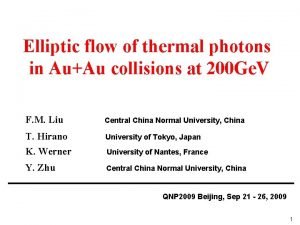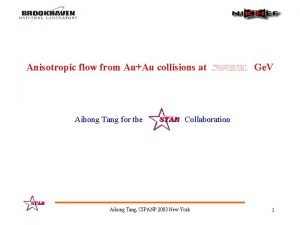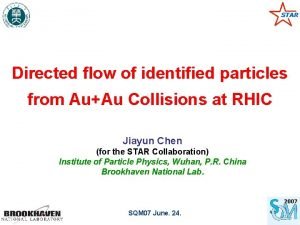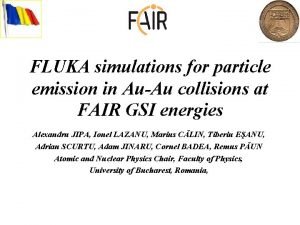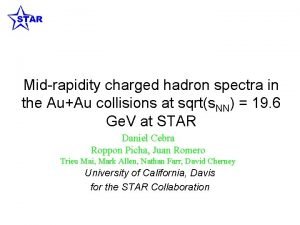Results on AuAu collisions at 130 and 200




































- Slides: 36

Results on Au+Au collisions at 130 and 200 AGe. V from the PHENIX experiment Thomas Peitzmann Westfälische Wilhelms-Universität Münster T. Peitzmann

Outline introduction – motivation – experimental setup – direct photons – single electrons – J/y production global observables: – ET – multiplicity electromagnetic probes conclusions hadron production – identified particles: spectra, mean p. T, d. N/dy – high p. T neutral pion production – particle ratios azimuthal correlations – elliptic flow – jets T. Peitzmann

The Search for the Quark-Gluon-Plasma two phases of strongly interacting matter – ordinary hadronic matter – quark-gluon-plasma » deconfinement » chiral symmetry restoration fundamental understanding of QCD! achievable in – big bang – neutron stars – high energy nuclear reactions T. Peitzmann

Phase Diagram of Strongly Interacting Matter circumstantial evidence for new phase of matter at SPS – dominated by hadronic phase experiments at RHIC (200 Ge. V) – higher energy density and temperature in the initial state – longer lifetime of possible QGP phase – theoretically easier – new observables » jets » heavy quarks T. Peitzmann

QGP Signatures many fascinating hints for new “state of matter” at SPS – – – J/y suppression strangeness enhancement direct photon emission di-electron anomaly. . . opportunities at RHIC – clearer signatures » larger e and T – new domains » hard scattering important » jet quenching as signature jet quenching – parton energy loss in hot, dense matter » medium induced gluon radiation – non-linear (DE L 2) » interference, multiple scattering – sensitive to deconfinement!? – reduced particle yield at high p. T – disappearance of jet structures T. Peitzmann

T. Peitzmann

The PHENIX Experiment PHENIX = Pioneering High Energy Nuclear Interaction e. Xperiment study of nuclear matter under extreme conditions (quark-gluonplasma) – focus on penetrating probes (g, e+e-, m+m-) » sensitive to early phase – identified hadrons at high p. T – global variables, flow, interferometry, fluctuations, . . . – nuclear reactions at the highest available beam energies » Au+Au at 200 AGe. V a multitude of observables future: measurement of the spin structure of the proton – polarized proton beams – e. g. measurement of the polarized gluon structure functions » quark-gluon-Compton-scattering T. Peitzmann

Experimental Setup two central detector arms – charged particle tracking and PID – EM calorimetry two muon arms – muon tracking and ID global detectors (trigger, centrality, vertex) » Beam-Counter » Zero-Degree-Calorimeter T. Peitzmann

PHENIX – Run II Au-Au at Ecm = 200 Ge. V – RHIC delivered 42 mb-1 to PHENIX – “minimum bias” and Level-2 triggers: 24 mb-1 Proton-Proton at Ecm = 200 Ge. V – RHIC delivered 700 nb-1 to PHENIX – “minimum bias” and Level-1 triggers 150 nb-1 T. Peitzmann

Excellent Particle Identification Hadron ID in TOF Electron ID in RICH and EMCal All charged tracks Apply RICH cut Real Net signal Background EMC energy / Momentum T. Peitzmann

Global Variables charged multiplicity and transverse energy significantly higher at RHIC compared to SPS weak centrality dependence of Nch/Npart and ET/Npart energy density in 2% most central collisions T. Peitzmann

Nch Model Comparison HIJING X. N. Wang and M. Gyulassy, PRL 86, 3498 (2001) EKRT K. J. Eskola et al, Nucl Phys. B 570, 379 and Phys. Lett. B 497, 39 (2001) KLN D. Kharzeev and M. Nardi, Phys. Lett. B 503, 121 (2001) D. Kharzeev and E. Levin, Phys. Lett. B 523, 79 (2001) Mini-jet S. Li and X. N. Wang Phys. Lett. B 527: 85 -91 (2002) T. Peitzmann

Identified Charged Hadron Spectra PHENIX Preliminary identified hadrons over large p. T-range protons ≈ pions at 2 Ge. V/c T. Peitzmann

Mean Transverse Momentum open symbols : 130 Ge. V data increase for peripheral collisions and saturation for central values and increase larger for heavier particles – collective transverse flow? T. Peitzmann

Pseudorapidity Density open symbols: 130 Ge. V data p+ p+ K+ K- p Positive weak centrality dependence of (NX/dy)/Npart behavior similar for 130 and 200 Ge. V pbar Negative T. Peitzmann

Suppression of Hadron Production M. M. Aggarwal et al. , Eur. Phys. J. C 23, 225 -236, 2002 K. Adcox et al. , Phys. Rev. Lett. 88, 22301 (2002) ratio of p. T-spectra – AA central / pp RAA =1 for scaling with number of binary collisions RAA < 1 for central Au+Au reactions at RHIC (130 AGe. V) RAA > 1 for reactions at SPS and ISR T. Peitzmann

The Reference: Spectra in pp at 200 Ge. V measurement of neutral pion spectra in pp – reference for AA » same detector, same systematics as AA consistent with p. QCD calculations T. Peitzmann

Neutral Pion Spectra in Au+Au at 200 Ge. V T. Peitzmann

Suppression in Hadron Spectra – The Nuclear Modification Factor nuclear modification factor – p. T-spectra for AA-central/pp strong suppression in p 0: – decreasing with p. T – factor 6 at p. T = 6 -8 Ge. V/c similar suppression in charged hadrons – RAA slightly higher at intermediate p. T? T. Peitzmann

High p. T Neutral Pion Suppression – Comparison To Theory p. QCD calculations: – P. Levai, Nucl. Phys. A 698 (2002) 631 – X. N. Wang, Phys. Rev. C 61 (200) 064910 – I. Vitev, talk at QM 2002 so far suppression not described by theories – calculations without energy loss completely off – energy loss calculations show different p. T dependence T. Peitzmann

Centrality Dependence of Suppression RAA for neutral pions as a function of centrality – gradual decrease – stronger decrease for higher p. T no threshold effect – surface-to-volume? » high p. T particle emission only from surface? T. Peitzmann

Chemical Composition at High p. T p/p and p/p ratios ≈1 for p. T = 3 Ge. V/c in central collisions p/p ratio decreasing at high p. T? – also in central collisions? T. Peitzmann

Chemical Composition at High p. T ratio p/h ≈ 0. 5 in min. bias – similar in central reactions important baryon and/or kaon contribution out to p. T = 9 Ge. V/c? – different from p. QCD expectations? T. Peitzmann

Elliptic Flow in Minimum Bias Au+Au at 200 AGe. V azimuthal asymmetry in particle emission PHENIX preliminary – strong effect due to pressure gradient (hydrodynamic flow) flow saturates for p. T > 3 Ge. V/c – asymmetry in hard scattered particles – asymmetric jet quenching? T. Peitzmann

Jet Evidence in Azimuthal Correlations at RHIC correlation of charged tracks with g (p 0) in triggered events – trigger particle p. T > 2. 5 Ge. V/c – Df distribution for p. T = 2 -4 Ge. V/c signature of jets in Au+Au – consistent with PYTHIA calculations and p+p data similar correlations between pairs of charged particles fit of jet signal with Gaussian – width decreases as a function of p. T – transverse momentum relative to jet axis consistent with expectation for jet fragmentation T. Peitzmann

Photon Measurements direct photon analysis in PHENIX – search for thermal photons – prompt photons as “calibration” for high p. T hadron production PHENIX preliminary no significant excess over hadron decays observed – promising results – important: redundancy of PHENIX » photon measurements in two different EMCal detectors and via conversion » two calorimeters yield c onsistent results » conversion method under study – significantly reduced systematic errors in the future PHENIX preliminary T. Peitzmann

Single Electron Spectra electron measurements in PHENIX – tracking in Drift- and Pad. Chambers – identification in RICH and EMcalorimeter yield and spectral shape consistent with PYTHIA calculation scaling with binary collisions – little energy loss? subtraction of background – photon conversions from mesons and p 0 -Dalitz dominant » pions measured in the same experiment! » identification of photonic sources by converter method physics signal? – main source: open charm? T. Peitzmann

J/y in p+p Collisions J/y �+ �- J/y m+ m - T. Peitzmann

J/y Cross Section in p+p Collisions rapidity distribution energy dependence of total cross section T. Peitzmann

J/y in Au+Au Collisions centrality dependence – normalized to binary collisions T. Peitzmann

Summary quenching of high p. T hadrons in central reactions established – neutral pions suppressed by 1/6 up to p. T = 8 Ge. V/c – suppression continuous in centrality (no threshold) – decreasing <p. T> at high p. T for charged hadrons chemical composition not (yet) jet-like – only ≈50% of hadrons are pions – role of baryons at high p. T (p/p, p/p)? saturation of v 2 for p. T > 3 Ge. V/c – hydrodynamics important for p. T < 3 Ge. V/c? – amount of v 2 from partial quenching? jets re-discovered in AA at RHIC – near-side correlation with trigger photon – most trigger particles (decay gamma) for p. T > 2. 5 Ge. V/c from jets? ! T. Peitzmann

Summary 2 promising first results for electromagnetic probes – direct photon analysis under way – single electrons consistent with charm predictions from p. QCD – J/y cross section measured in p+p – J/y measured in Au+Au – eagerly waiting for higher luminosity many more results from hadrons and global observables – – – multiplicity transverse energy identified hadrons elliptic flow not discussed: » » interferometry fluctuations production of L and deuterons. . . T. Peitzmann

Energy Dependence of p. T-spectra in pp and AA spectra in pp K. Reygers et al. , Hirschegg 2002 – strong variation with beam energy – “flattening” of spectra – power law » influence of hard scattering spectra in AA – little variation with beam energy – almost exponential » influence of thermal production? T. Peitzmann

Interlude: Thermalization and Hadron Spectra spectra of pions and (anti)protons description by hydrodynamical source T. P. , nucl-th/ 0207012 – perfect description possible Tch = 172 ± 2 Me. V m. B = 37 ± 4 Me. V Tkin = 123 ± 6 Me. V < b. T > = 0. 45 ± 0. 02 doesn’t explain suppression – need stronger suppression to account for additional hydrodynamic production T. Peitzmann

New Results at 200 Ge. V identified particles are best! PHENIX neutral pions at high p. T identified charged particles to come? T. Peitzmann

Centrality Selection ZDC vs BBC Define centrality classes: ZDC vs BBC ET b Nch EZDC QBBC Extract N participants: Glauber model PHENIX preliminary Nch PHENIX preliminary ET T. Peitzmann
 100+200+200
100+200+200 Auau
Auau Auau
Auau Auau
Auau Auau
Auau 200+200+100+100
200+200+100+100 200+400+600
200+400+600 200+200+300
200+200+300 200 + 200 + 300
200 + 200 + 300 200+100+300
200+100+300 200+200+300+300
200+200+300+300 A freight train is being assembled in a switching yard
A freight train is being assembled in a switching yard A small marble collides with a billiard ball
A small marble collides with a billiard ball Momentum and collisions review
Momentum and collisions review Inelastic collision
Inelastic collision Collisions and explosions
Collisions and explosions Collisions and explosions
Collisions and explosions Formula of collision
Formula of collision Chapter 6 momentum
Chapter 6 momentum Aplusphysics momentum-impulse answer key
Aplusphysics momentum-impulse answer key Type of collisions
Type of collisions Impulse and acceleration
Impulse and acceleration To avoid collisions a defensive driver should
To avoid collisions a defensive driver should Momentum with friction equation
Momentum with friction equation Necessary for successful collisions to occur
Necessary for successful collisions to occur Inelastic collision examples real world
Inelastic collision examples real world Types of collision
Types of collision Momentum is conserved in all collisions
Momentum is conserved in all collisions The space between traffic clusters is called
The space between traffic clusters is called The motion of electrons between two successive collisions
The motion of electrons between two successive collisions Collision frequency formula
Collision frequency formula To avoid collisions a defensive driver should
To avoid collisions a defensive driver should Prévention des collisions engins-piétons
Prévention des collisions engins-piétons Collisions
Collisions Doctrine and covenants 130
Doctrine and covenants 130 Properties of kites and trapezoids
Properties of kites and trapezoids Shakespeare sonnet 130 rhyme scheme
Shakespeare sonnet 130 rhyme scheme

